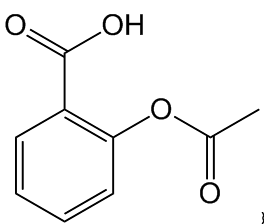Learning objectives
|
There are a number of drugs used in Stroke medicine and this is just a review. Aspirin and clopidogrel provide significant clinical benefit in patients with stroke and cardiovascular disease. However, it should be noted that aspirin or clopidogrel prevent only a small proportion of such events. Other agents e.g Prasugrel and Ticagrelor used in coronary disease are under evaluation for stroke.
Aspirin is a well-studied drug. Its pharmacological interest started with the fact that willow bark had anti fever properties. The Assyrians (4000 BC) and Sumerians (3500 BC), were aware of its medicinal merits. However, it took until the 1970s until we understood that aspirin acts to inhibit the enzymes COX 1 and COX 2 involved in prostaglandin synthesis. Sir John Vane, a British Pharmacologist proved the anticoagulant properties of aspirin by blocking the biosynthesis of prostaglandin, the pain messengers. He suggested that aspirin may reduce the risk of cardiovascular disease which led to use low-dose aspirin as a preventative measure in various cardiac conditions and then on to its application in stroke. It has several functions or characteristics and can act as an anti-inflammatory, Analgesic, Antipyretic, Antithrombotic and reduces TXA-B2. It is generally avoided in those under 16 as there is a risk of Reye's syndrome. Also avoid in Peptic ulcer disease, Allergy, Bleeding disorders, Asthma, G6PD. Side effects include GI irritation, GI ulceration, Reye syndrome, Anaphylaxis and allergy
Aspirin (acetylsalicylic acid) acts by inhibiting platelet function by acetylating the platelet cyclooxygenase (COX) at the functionally important amino acid serine. This prevents arachidonic acid reaching the catalytic site of the enzyme and results in an irreversible inhibition of platelet-dependent thromboxane formation. Aspirin is predominantly a COX-1 inhibitor rather than COX-2 which is expressed by cytokines, inflammatory stimuli, and some growth factors. This explains low dose needed for antithrombotic (COX-1) activity and the higher doses needed for anti-inflammatory drug (COX-2). The optimum antiplatelet dose varies internationally - In the UK 75 mg/day and in the USA 81 mg/day and elsewhere 100 mg/day.
Dose [ Max dose 4 g/day] Clopidogrel is a P2Y12 Platelet Inhibitor. The mechanism of action of clopidogrel is as a P2Y12 Receptor Antagonist. The physiologic effect of clopidogrel is by means of decreased platelet aggregation through its actions and belongs to the Thienopyridine-class of antiplatelets which irreversibly inhibit receptor called P2Y12 on platelets. It is a prodrug and needs liver metabolic pathways shared with other drugs such as PPIs. It is metabolised by CYP2C19. PPIs can reduce the formation of and so the effectiveness of Clopidogrel and should either be stopped if possible or switched to Pantoprazole or taken at different times at least 4 hrs apart.
Trials Several trials have looked at combination therapy in different groups. The Chance trial was a randomised, double-blind, placebo-controlled trial conducted at 114 centres in China. 5170 patients within 24 hours after the onset of minor ischaemic stroke or high-risk TIA to combination therapy with clopidogrel and aspirin.
(c or to placebo plus aspirin (75 mg per day for 90 days). All participants received open-label aspirin at a clinician-determined dose of 75 to 300 mg on day 1. The primary outcome was stroke (ischaemic or haemorrhagic) during 90 days of follow-up in an intention-to-treat analysis. Treatment differences were assessed with the use of a Cox proportional-hazards model, with study centre as a random effect.
Arms of trials
Results
Dipyridamole (Persantin) was introduced in the late 1950s as an antianginal medication, as it was found to have coronary vasodilator properties and so increased coronary blood flow without significantly affecting myocardial oxygen consumption. Antiplatelet effects were subsequently demonstrated in animals and humans, and since then, the drug has been advocated as an antithrombotic agent.
Dipyridamole inhibits platelet phosphodiesterase, thereby preventing the degradation of cAMP (cyclic AMP) to AMP. An increased platelet cAMP reduces platelet reactivity by decreasing cytoplasmic calcium and inhibiting platelet prostaglandin synthesis. The adenosine transport blocking effects of dipyridamole also produce elevation of tissue adenosine levels. Furthermore, dipyridamole potentiates the effects of prostacyclin by increasing synthesis, enhancing release and inhibiting the metabolic degradation of prostacyclin.
Trials
Dipyridamole has no significant affect by itself and is usually used in collaboration with Aspirin 75 mg OD. Formulation Dipyridamole is usually given as Dipyridamole 200 mg Capsules bd with Aspirin 75 mg OD. The main drawback of the drug is the headache which can be severe but usually settles after 1-2 days. The headache caused 9% of patients to quit Dipyridamole on ESPRIT. It can be almost thunderclap and is a testament to the vasodilator properties of the drug.
Introduction
Aspirin

Trials
Clopidogrel (Plavix)
Combined Aspirin and Clopidogrel
Dipyridamole